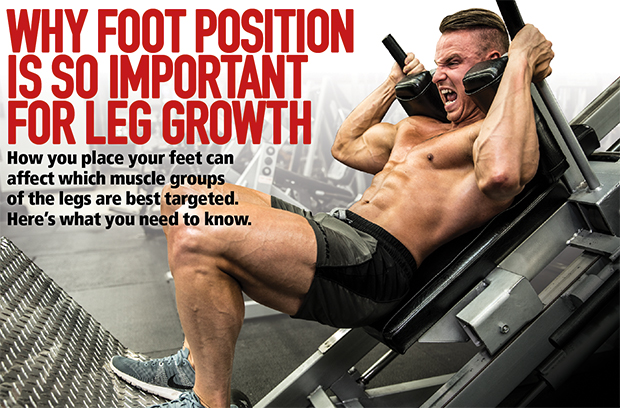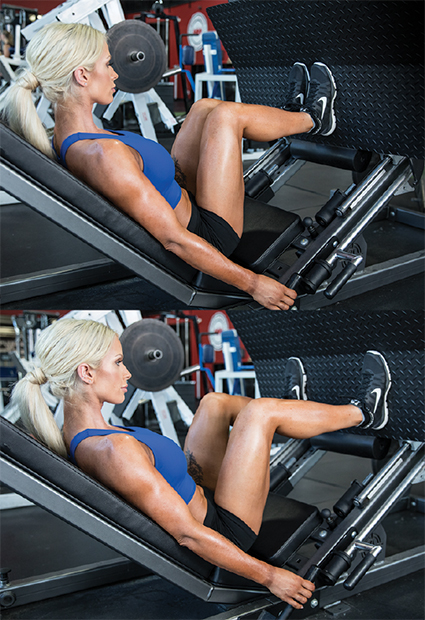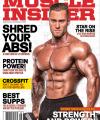Why Foot Position Is So Important for Leg Growth

Placing your feet high or low, or wide vs. close, can affect which muscle groups of the legs are best targeted. Here’s what you need to know.
When training legs, there are a number of pointers to try to keep in mind: maintaining a flat back, descending to a point in which your thighs are about parallel to the floor, and keeping your knees tracking in line. But did you ever give much thought to foot position?
Typically, you want your feet about hip-width to shoulder-width apart, with toes pointed slightly outward for a powerful base from which to push off. This foot position also hits the major muscle groups pretty evenly. (Important note: This isn’t necessarily an optimal foot position for everyone, especially taller lifters. While this is a great place to start when trying to determine optimal foot position, genetic factors or injuries may require a wider stance or straightforward foot position.)
 Some exercises—notably the leg press, hack squat, Smith-machine squat, and horizontal leg-press machine—allow you to place your feet anywhere on the foot platform: high to low, close to wide. While the aforementioned foot position is still a good place to start, foot-placement options are now available that allow you to target specific muscle groups more heavily than others. Let’s take a closer look.
Some exercises—notably the leg press, hack squat, Smith-machine squat, and horizontal leg-press machine—allow you to place your feet anywhere on the foot platform: high to low, close to wide. While the aforementioned foot position is still a good place to start, foot-placement options are now available that allow you to target specific muscle groups more heavily than others. Let’s take a closer look.
Range of Motion Around a Pair of Joints
 You’ve no doubt heard you should never allow your knees to travel beyond the plane of your toes, but that’s true mainly from a knee-health perspective: If your knees are fine, it’s not really a problem (though I’d argue that it’s not a good idea in the long term). Knowing that should tip you off: If a movement stresses the knees more, it’s also stressing the muscles that attach to the knee more as well, and those would be the quads, specifically the lower region. It also means there’s less stress on muscles near the hips, so the upper quads and glutes are getting less activation.
You’ve no doubt heard you should never allow your knees to travel beyond the plane of your toes, but that’s true mainly from a knee-health perspective: If your knees are fine, it’s not really a problem (though I’d argue that it’s not a good idea in the long term). Knowing that should tip you off: If a movement stresses the knees more, it’s also stressing the muscles that attach to the knee more as well, and those would be the quads, specifically the lower region. It also means there’s less stress on muscles near the hips, so the upper quads and glutes are getting less activation.
Which foot position allows greater encroachment of the knees near or beyond the plane of the toes then? In fact, you see that when you place your feet near the bottomof foot platforms, regardless of what exercise you’re doing. Exercise scientists would say such movements have greater range of motion around the knee joint (as compared to the hip joint), and a greater degree of knee flexion and extension (compared to the hip).
On the opposite end is when you place your feet high on a platform. Just by assuming it’s the opposite of the above—that it reduces knee flexion and ROM around the knee joint and increases the ROM around the hip joint—you would get the correct answer. With greater hip extension and flexion, you can emphasize the glutes and upper quads more effectively. Visually, your knees aren’t coming close to passing the plane coming up from your toes, an important visual cue.
Remember, this shift in focus isn’t absolute. You simply can’t isolate one muscle group over another; rather, you emphasize.
In general, wider-stance movements work the inner thighs more strongly; conversely, a closer stance better targets the outer thighs. If nothing else, you just learned a whole bunch of variations for multi-joint leg exercises, which is especially useful when targeting specific lagging areas or just for adding variety to your workout.
A special word on Smith-machine squats: While there’s no foot plate from which to push, simply placing your feet well out in front of your toes serves the same purpose as using a higher foot placement: The glutes and upper quads get greater emphasis.
But What About Hams?
 The hamstrings are an antagonist muscle to the quads such that when one is contracting, the other is being stretched. In that sense, the lower hamstrings are contracting as you lower yourself by controlling the speed of the descent (the quads are stretching here). As you rise up, the glutes kick in, and the further you rise up, your quads start to take over as the hamstrings are now being stretched. Just remember this:
The hamstrings are an antagonist muscle to the quads such that when one is contracting, the other is being stretched. In that sense, the lower hamstrings are contracting as you lower yourself by controlling the speed of the descent (the quads are stretching here). As you rise up, the glutes kick in, and the further you rise up, your quads start to take over as the hamstrings are now being stretched. Just remember this:
1. As you descend, the lower hamstrings get a greater emphasis when there’s greater ROM around the knee joint (your feet are low) and the upper hams get more of the hamstring emphasis on movements with greater hip-joint ROM (your feet are higher on the footplate).
2. Going deeper into movements, whether your feet are low or high, is especially beneficial to the hams and glutes. (Remember, when you come out of the hole, the quads aren’t really kicking in right away.)
3. Such hamstrings work does notreplace dedicated hamstrings exercises in your workout, including leg-curl movements and Romanian deadlifts.
4. Doing partial reps (like the guy who puts a ton of plates on the bar and descends just a few inches) means missing out on a ton of muscle growth. That’s why you hear the recommendation to go to a thighs-parallel position. Partial reps, however, can be done as a complementto full-rep training.

